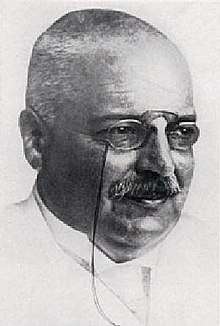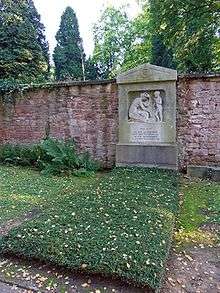Alois Alzheimer
Aloysius Alzheimer (also known as Alois Alzheimer; /ˈɑːltshaɪmər, ˈælts-, ˈɔːlts-/;[1] German: [ˈaːlɔɪs ˈaltshaɪmɐ]; 14 June 1864 – 19 December 1915) was a German psychiatrist and neuropathologist and a colleague of Emil Kraepelin. Alzheimer is credited with identifying the first published case of "presenile dementia", which Kraepelin would later identify as Alzheimer's disease.[2]
Alois Alzheimer | |
|---|---|
 Alois Alzheimer | |
| Born | Aloysius Alzheimer 14 June 1864 |
| Died | 19 December 1915 (aged 51) Breslau, Province of Silesia, Kingdom of Prussia, German Empire (present-day Wrocław, Lower Silesia, Poland) |
| Education |
|
| Known for | First published case of "presenile dementia" (Alzheimer's disease) |
| Medical career | |
| Profession | Psychiatrist, physician |
| Institutions |
|
| Sub-specialties | Neuropathology |
| Signature | |
 | |
Early life and education
Aloysius Alzheimer was born in Marktbreit, Bavaria on 14 June 1864, the son of Anna Johanna Barbara Sabina and Eduard Román Alzheimer.[3][4] His father served in the office of notary public in the family's hometown.[5]
The Alzheimers moved to Aschaffenburg when Alois was still young in order to give their children an opportunity to attend the Royal Humanistic Gymnasium. After graduating with Abitur in 1883, Alzheimer studied medicine at University of Berlin, University of Tübingen, and University of Würzburg. In his final year at university, he was a member of a fencing fraternity, and even received a fine for disturbing the peace while out with his team.[6] In 1887, Alois Alzheimer graduated from Würzburg as Doctor of Medicine.[6]
Career
The following year, he spent five months assisting mentally ill women before he took an office in the city mental asylum in Frankfurt am Main, the Städtische Anstalt für Irre und Epileptische (Asylum for Lunatics and Epileptics). Emil Sioli, a noted psychiatrist, was the dean of the asylum. Another neurologist, Franz Nissl, began to work in the same asylum with Alzheimer. Together, they conducted research on the pathology of the nervous system, specifically the normal and pathological anatomy of the cerebral cortex.[6] Alzheimer was the co-founder and co-publisher of the journal Zeitschrift für die gesamte Neurologie und Psychiatrie, though he never wrote a book that he could call his own.
While at the Frankfurt asylum, Alzheimer also met Emil Kraepelin, one of the best-known German psychiatrists of the time. Kraepelin became a mentor to Alzheimer, and the two worked very closely for the next several years. When Kraepelin moved to Munich to work at the Royal Psychiatric Hospital in 1903, he invited Alzheimer to join him.[6]
At the time, Kraepelin was doing clinical research on psychosis in senile patients; Alzheimer, on the other hand, was more interested in the lab work of senile illnesses.[7] The two men would face many challenges involving the politics of the psychiatric community. For example, both formal and informal arrangements would be made among psychiatrists at asylums and universities to receive cadavers.[7]
In 1904, Alzheimer completed his Habilitation at Ludwig Maximilian University of Munich, where he was appointed as a professor in 1908. Afterwards, he left Munich for the Silesian Friedrich Wilhelm University in Breslau in 1912, where he accepted a post as professor of psychiatry and director of the Neurologic and Psychiatric Institute. His health deteriorated shortly after his arrival so that he was hospitalized. Alzheimer died three years later.[6]
Auguste Deter
In 1901, Alzheimer observed a patient at the Frankfurt asylum named Auguste Deter. The 51-year-old patient had strange behavioral symptoms, including a loss of short-term memory; she became his obsession over the coming years. Auguste Deter was a victim of the politics of the time in the psychiatric community; the Frankfurt asylum was too expensive for her husband. Herr Deter made several requests to have his wife moved to a less expensive facility, but Alzheimer intervened in these requests. Frau Deter remained at the Frankfurt asylum, where Alzheimer had made a deal to receive her records and brain upon her death.[7]
On 8 April 1906, Frau Deter died, and Alzheimer had her medical records and brain brought to Munich where he was working in Kraepelin's laboratory. With two Italian physicians, he used the staining techniques of Bielschowsky to identify amyloid plaques and neurofibrillary tangles. These brain anomalies would become identifiers of what later became known as Alzheimer's disease.[8]
Findings
Alzheimer discussed his findings on the brain pathology and symptoms of presenile dementia publicly on 3 November 1906, at the Tübingen meeting of the Southwest German Psychiatrists.[6] The attendees at this lecture seemed uninterested in what he had to say. The lecturer that followed Alzheimer was to speak on the topic of "compulsive masturbation", which the audience was so eagerly awaiting that they sent Alzheimer away without any questions or comments on his discovery of the pathology of a type of senile dementia.[6]
Following the lecture, Alzheimer published a short paper summarizing his lecture; in 1907 he wrote a larger paper detailing the disease and his findings.[6] The disease would not become known as Alzheimer's disease until 1910, when Kraepelin named it so in the chapter on "Presenile and Senile Dementia" in the 8th edition of his Handbook of Psychiatry. By 1911, his description of the disease was being used by European physicians to diagnose patients in the US.[9]
Contemporaries
American Solomon Carter Fuller gave a report similar to that of Alzheimer at a lecture five months before Alzheimer.[6] Oskar Fischer was a fellow German psychiatrist, 12 years Alzheimer's junior, who reported 12 cases of senile dementia in 1907 around the time that Alzheimer published his short paper summarizing his lecture.[10]
Alzheimer and Fischer had different interpretations of the disease, but due to Alzheimer's short life,[10] they never had the opportunity to meet and discuss their ideas.[11]
Among the doctors trained by Alois Alzheimer and Emil Kraepelin at München in the beginning of the XXth century were the Spanish neuropathologists Nicolás Achúcarro and Gonzalo Rodríguez Lafora, two distinguished disciples of Santiago Ramón y Cajal and members of the Spanish Neurological School. Alzheimer recommended the young and brilliant Nicolás Achúcarro to organize the neuropathological service at the Government Hospital for the Insane, at Washington D.C. (current, NIH), and after two years of work, he was substituted by Gonzalo Rodríguez Lafora.
Personal life
In 1894, he married Cecilie Simonette Nathalie Geisenheimer, with whom he had three children. Cecilie died in 1901.
Death

In August 1912, Alzheimer fell ill on the train on his way to the University of Breslau, where he had been appointed professor of psychiatry in July 1912. Most probably he had a streptococcal infection and subsequent rheumatic fever leading to valvular heart disease, heart failure and kidney failure. He had not recovered completely from this illness.
He died of heart failure on 19 December 1915 at age 51, in Breslau, Silesia (present-day Wrocław, Poland). He was buried on 23 December 1915 next to his wife in the Hauptfriedhof in Frankfurt am Main.[12]
Another hypothesis offered by Claire O'Brien was that Auguste Deter actually had a vascular dementing disease.[9]
Other interests
Alzheimer was known for having a variety of medical interests including vascular diseases of the brain, early dementia, brain tumors, forensic psychiatry and epilepsy.[13] Alzheimer was a leading specialist in histopathology in Europe.[13] His colleagues knew him to be a dedicated professor and cigar smoker.[6]
See also
- Gaetano Perusini
- German inventors and discoverers
References
- "Alzheimer's disease". Random House Webster's Unabridged Dictionary.
- Berrios, G. E. (1 November 1990). "Alzheimer's disease: A conceptual history". International Journal of Geriatric Psychiatry. 5 (6): 355–65. doi:10.1002/gps.930050603. ISSN 1099-1166.
- Zilka, N.; M. Novak (2006). "The tangled story of Alois Alzheimer" (PDF). Bratisl Lek Listy. 107 (9–10): 343–45. PMID 17262985. Retrieved 4 September 2012.
- Maurer, Konrad; Maurer, Ulrike (4 May 2006). Alzheimer. La vida de un médico y la historia de una enfermedad. Ediciones Díaz de Santos. ISBN 9788479787585.
- "Alzheimer´s Birthplace" Archived 21 December 2008 at the Wayback Machine, marktbreit.de; accessed 14 July 2017.(in German)
- Cipriani, Gabriele; Dolciotti, Cristina; Picchi, Lucia; Bonuccelli, Ubaldo (2011). "Alzheimer and his disease: a brief history". Neurological Sciences. 32 (2): 275–79. doi:10.1007/s10072-010-0454-7. ISSN 1590-1874. PMID 21153601.
- Engstrom, Eric J. (2007). "Researching Dementia in Imperial Germany: Alois Alzheimer and the Economies of Psychiatric Practice". Culture, Medicine and Psychiatry. 31 (3): 405–13. doi:10.1007/s11013-007-9060-4. ISSN 0165-005X. PMID 17914665.
- "Alois Alzheimer". Biography.com. 2 April 2014. Archived from the original on 23 March 2018. Retrieved 19 February 2019.
- Maurer K.; Maurer U. (2003). Alzheimer: The Life of a Physician and Career of a Disease. New York: Columbia University Press. ISBN 978-0-231-11896-5.
- Strobel, Gabrielle. "Prague: What say you, Alois—Should it be 'Alzheimer-Fischer' disease?". Journal of Alzheimer's Disease. 17 (3).
- Staff (16 November 2006). "Tuebingen: The Man Behind the Eponym". alzforum.org. Alzforum. Retrieved 25 January 2017.
- Graeber, M. B.; Mehraein, Parviz (1 December 1999). "Reanalysis of the first case of Alzheimer's disease". European Archives of Psychiatry and Clinical Neuroscience. 249 (3): S10–13. doi:10.1007/PL00014167. ISSN 0940-1334. PMID 10654094.
- Lefroy, Richard B. (2000). "Sign In". American Journal of Alzheimer's Disease. 15 (4): 252–255. doi:10.1177/153331750001500404.
External links
![]()
- Alzheimer's: 100 years on
- Alois Alzheimer's Biography, International Brain Research Organization
- Bibliography of secondary sources on Alois Alzheimer and Alzheimer's disease, selected from peer-reviewed journals.
- Graeber Manuel B. "Alois Alzheimer (1864-1915)" International Brain Research Organization